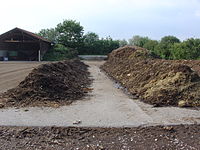
Photo from wikipedia
Abstract Composting can enhance the nutrient elements cycling and reduce carbon dioxide production. However, little information is available regarding the application of compost for the remediation of the contaminated soil.… Click to show full abstract
Abstract Composting can enhance the nutrient elements cycling and reduce carbon dioxide production. However, little information is available regarding the application of compost for the remediation of the contaminated soil. In this study, we assess the response of the redox capacities (electron accepting capacities (EAC) and electron donating capacities (EDC)) of compost-derived humic acids (HAs) to the bioreduction of hexavalent chromium (Cr(VI)), especially in presence of hematite. The result showed that the compost-derived HAs played an important role in the bioreduction of Cr(VI) in presence and absence of hematite under the anoxic, neutral (pH 7) and motionless conditions. Based on the pseudo-first order kinetic model, the rate constants of Cr(VI) reduction increased by 1.36–2.0 times when compost-derived HAs was added. The redox capacity originating from the polysaccharide structure of compost-derived HAs made them effective in the direct Cr(VI) reduction (without MR-1) at pH 7. Meanwhile, the reduction rates were inversely proportional to the composting treatment time. When iron mineral (Fe2O3) and compost-derived HAs were both present, the rate constants of Cr(VI) reduction increased by 2.35–5.09, which were higher than the rate of Cr(VI) reduction in HA-only systems, indicating that the hematite played a crucial role in the bioreduction process of Cr(VI). EAC and quinonoid structures played a major role in enhancing the bioreduction of Cr(VI) when iron mineral and compost-derived HAs coexisted in the system. The results can extend the application fields of compost and will provide a new insight for the remediation of Cr(VI)-contaminated soil.
Journal Title: Chinese Chemical Letters
Year Published: 2020
Link to full text (if available)
Share on Social Media: Sign Up to like & get
recommendations!